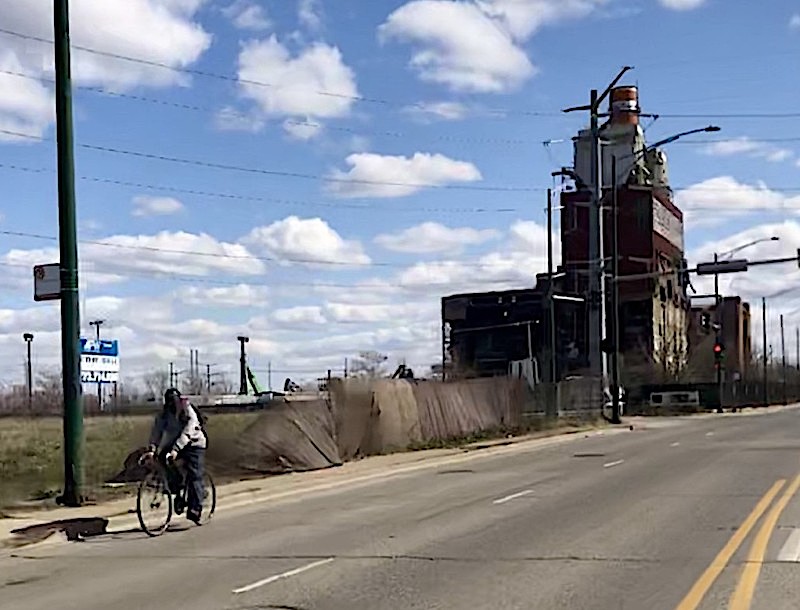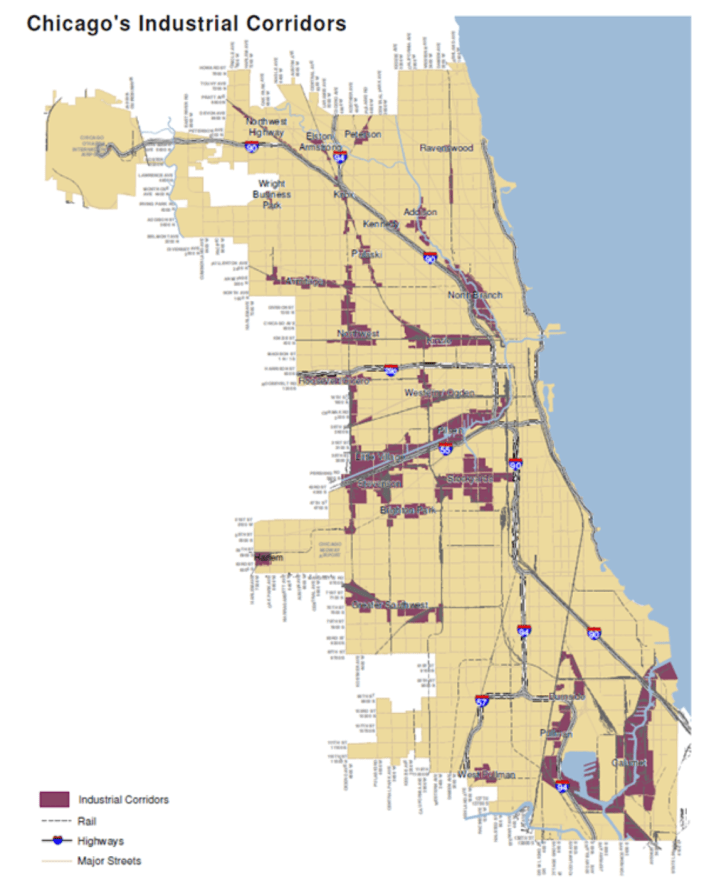Para leer este artículo en español, haga clic aquí.
As soon as you walk out of your door in Chicago, you step into an environment that was designed and built for movement. In certain parts of the city, movement is more accessible, more enjoyable, and healthier. You encounter streets and sidewalks that are well kept and clean, with tree canopies. You find schools, grocery stores, and workplaces within walking distance of homes. Some streets have little traffic and you rarely see heavy diesel trucks or polluting factories in proximity to parks and schools. These areas are often relatively affluent and majority-white, and located on the North Side.
There are other communities that are located where industry lies, and their residents are exposed to the pollution from factories and diesel truck traffic. In Chicago, these are officially-designated 26 industrial corridors. Industrial and manufacturing activities, such as asphalt plants, warehousing, etc. are restricted to these parts of the city. Another major purpose of these corridors is logistics, due to the districts’ proximity to rail, waterways like the Sanitary and Ship Canal, highways, and major streets that have robust retail strips. This allows for trucking corridors in which diesel trucks use major streets. The largest sources of pollution in industrial corridors come from diesel trucks that emit nitrogen dioxide, facilities that emit hazardous emissions, rail yards that are a source of particulate matter, brownfields that have contaminated soil, and asphalt plants that release volatile orgainc compounds. Today, the industrial corridors are located in predominantly Black and Brown communities.
On the Southwest Side, industries such as coal-fired power plants were prevalent. Plants like the Fisk and Crawford generating stations polluted the communities of Pilsen and Little Village for years. Residents were forced to inhale coal dust, and this led to many people developing respiratory illnesses, and contributed to hundreds of deaths. The Little Village Environmental Justice Organization, along with other originations like the Pilsen Environmental Rights and Reform Organization, organized and campaigned for over ten years until the factories were closed. To this day, these Southwest Side neighborhoods are still burdened by some of the worst air quality in the state.

In 2016, the Chicago Department of Planning and Development initiated the Industrial Corridor Modernization Initiative. The goals of this initiative are to “are to unleash the potential of select industrial areas for advanced manufacturing and technology-oriented jobs while reinforcing traditional industrial activities in other areas; maintain and improve the freight and public transportation systems that serve industrial users; support new job growth and local job opportunities; and leverage the unique, physical features of local industrial corridors to foster demand.”
In the Little Village Framework, the plan for the Little Village Industrial Corridor, the city highlighted employment in the transportation, manufacturing, and warehousing sectors and proposed to keep this neighborhood an employment center that is adjacent to retail. This means that even as the coal factories have closed, the Southwest Side will still be home to asphalt, rock and metal-crushing factories, and warehousing. In 2018, the City Council approved a 1-million-square-foot distribution center to be developed by Hilco. This distribution center will inevitably bring more heavy-duty diesel truck traffic without the promise of quality jobs to the local residents of Little Village. Warehouse jobs are extremely difficult and taxing. As we saw in December, workers have lost their lives because they were ordered by their company (Amazon) to continue working through a tornado.
The residents of these communities want something different. They want access to good jobs, and they also want to live in neighborhoods that are healthy and enjoyable. LVEJO proposes a Just Transition for this industrial corridor. They want the community to be involved in the redevelopment of land, and includes proposals for green job access, urban agriculture space, workforce training opportunities, and local entrepreneurship. This plan allows for a healthier environment and more safe employment opportunities at living wages for residents. Communities that are in proximity to major transportation systems are invaluable, but if environmental and health impacts are not considered for these communities, then we will continue to ask Black and Brown communities to bear the burden of pollution and contamination.
At the end of November 2021, the Regional Transportation Authority published a snippet of their work with the Chicago Department of Transportation and Sam Schwartz Engineering to conduct a 31st Street Corridor Study in Little Village that evaluates the places people visit; opportunities and challenges for walking, biking, and transit; congestion and parking issues; and truck nuisance. However, this short excerpt offers very little information on what the full study will entail. LVEJO reported that there will be two task force meetings in early 2022 and and provided a link to an interactive map where residents can share their experiences with challenges and opportunities at specific locations along the 31st Street corridor.
Please visit 31st Street Study Corridor Web Experience to share your experiences and opinions.




